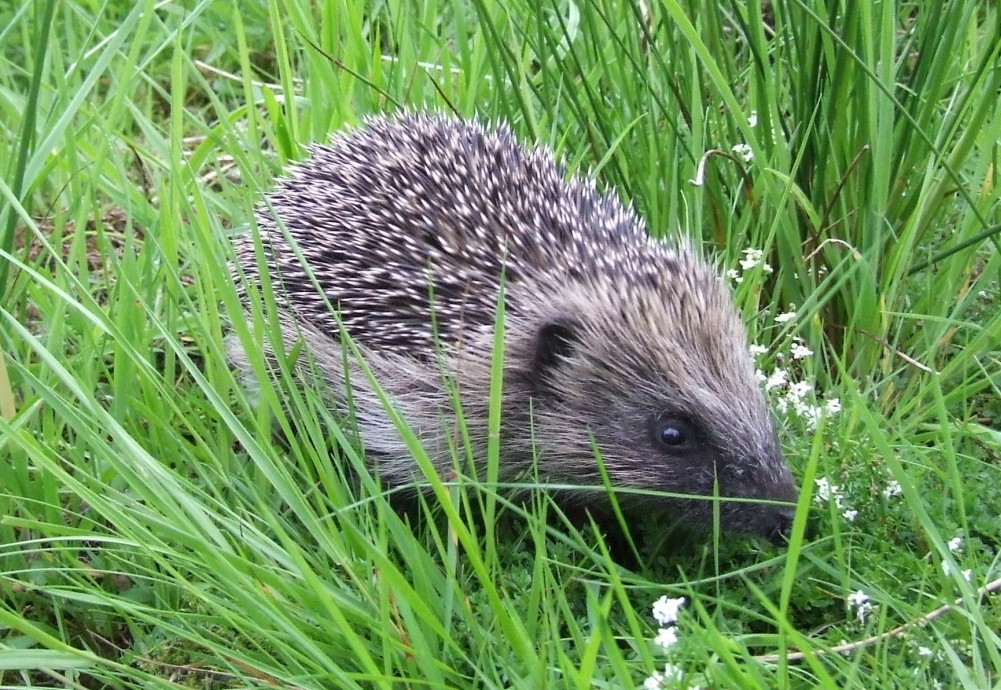Hedgehog

Status
IUCN Red List (GB): Vulnerable
Population
879,000
Scientific name
Erinaceus europaeus
The West-European Hedgehog Erinaceus europaeus
Hedgehogs are our only spiny mammal and are immediately recognisable. They are 22-28 cm long and have around 6,000 closely-packed, hollow, creamy white spines, becoming brown at the base and pure white at the tip. Just behind the point is a dark, chocolate-brown band. On their underside, hedgehogs have coarse, grey-brown fur. By rolling up into a tight ball and erecting their spines, hedgehogs can protect themselves from most natural enemies.
They have a short inconspicuous tail, small ears and relatively long legs, normally hidden under a ’skirt’ of long hairs. They are usually thought of as slow animals but they can move up to 40 metres a minute. They are mostly active at night or after heavy rainfall, and use their keen sense of smell to find food and alert them to danger. Between November and the end of March, when food is scarce, hedgehogs hibernate to conserve energy, remaining largely inactive. Adult hedgehogs weigh between 450 and 1500 g.
Where do hedgehogs live?
Wide range of habitats, in both urban and rural situations. Absent from large conifer plantations, marshes & moorlands. Suburban and urban gardens increasingly important. Hedgehogs are found throughout western Europe, including mainland Britain and Ireland, but are absent from some Scottish Islands and have been introduced to others.
What do hedgehogs eat?
Ground-dwelling invertebrates especially worms, beetles, slugs, caterpillars, millipedes and earwigs. They also eat birds eggs and carrion. Readily eat meaty cat food or dog food provided by people too!
What are their habits?
Generally solitary, non-territorial, nocturnal. Mobile and wide-ranging. Travel 1-2km a night, with urban range sizes involving many different gardens. Hibernate in winter. Tend to follow linear features when foraging. Rolls into a ball when threatened.
Breeding
Breed between April and September, with peak activity in May and June. Courtship involves lots of snorting, barging from the female and perseverance from the male. Mothers may desert or eat young if disturbed while nesting. Up to seven blind, spineless offspring are usually born between May and August in a nest of leaves and grass. Pure white spines appear soon after birth and are replaced within a few weeks by darker spines that grow through. The young are weaned at about four weeks and become independent shortly afterwards. Hoglets emerge from end of June onwards, are weaned at around five weeks and independent from then on. Females can attempt two litters in a year, but rarely rear more than one successfully.
Conservation status
Although still relatively common and widespread, there is now considerable evidence for a dramatic decline in recent years, with around a third of the national population lost since the millennium. Declining in both rural and urban habitats, due to a range of factors. The hedgehog is legally protected from trapping or intentional harm, but none of the legislation deals with the drivers of the decline. Hedgehog Street is the only national conservation project and focuses on making gardens hedgehog-friendly.
How long do hedgehogs live for?
Average of about two years. A small percentage will reach five years.
GB population size & distribution
There is still no robust way of calculating the size of hedgehog populations. Our best estimate for the total population size is 879,000.
Did you know?
Occasionally, some hedgehogs produce large amounts of frothy saliva and spread it over their spines. The purpose of this ‘self-anointment’ is still a mystery.
To find out more about hedgehogs visit www.hedgehogstreet.org.
